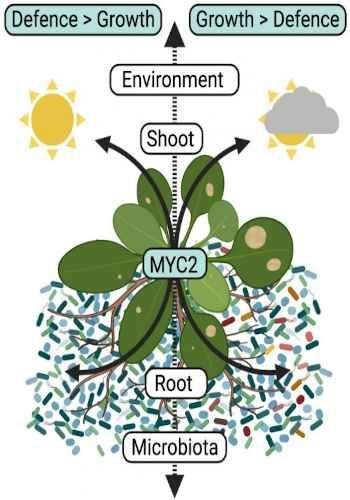
PRIORITY TO MICROBIOTA-INDUCED PLANT GROWTH OVER DEFENSE, UNDER LOW LIGHT CONDITIONS.
Land plants - plants that live primarily in terrestrial habitats and form vegetation on earth - are anchored to the ground through their roots, and their performance depends on both the belowground soil conditions and the aboveground climate. Plants utilize sunlight to grow through the process of photosynthesis where light energy is converted to chemical energy in chloroplasts, the powerhouses of plant cells. Therefore, the amount and quality of light perceived by chloroplasts through light absorbing pigments, such as chlorophyll, is a defining factor in plant growth and health. A substantial amount of the chemical compounds produced during the conversion of light energy to chemical energy, termed photoassimilates (mainly sugars), is translocated to the plant root compartment and invested in the surrounding soil to sustain microbial growth. Consequently, roots harbour complex microbial communities of bacteria and filamentous eukaryotes (i.e., fungi and oomycetes), and the composition of these communities profoundly influences plant performance. However, the extent to which plants can take advantage of belowground microbes to orchestrate aboveground stress responses remains largely unexplored. Now, in a new study published in Nature Plants, Stéphane Hacquard and his colleagues from the Department of Plant-Microbe Interactions at the MPIPZ in Cologne, Germany, shed light on these aboveground-belowground connections.
To tackle this question, the first author of the study Shiji Hou performed experiments where the aboveground light conditions and the belowground microbial conditions could be controlled. By comparing the growth of Arabidopsis thaliana (Thale Cress) grown in the absence of root microbes (i.e., germ-free) to those colonized by a complex community of 183 bacteria, 24 fungi and 7 oomycetes, the researchers observed that the presence of microbes rescued the plant growth-deficiency observed under low light conditions. Inoculation experiments with leaf pathogens further indicated that plants colonized by microbes were also more resistant to aboveground leaf pathogens than germ-free control plants, indicating that the presence of root microbes can promote both plant growth and defense under low light.